Fifth USA National ARDF Championships
and Third IARU Region 2 ARDF Championships
Albuquerque, New Mexico, August 1 - 6, 2005
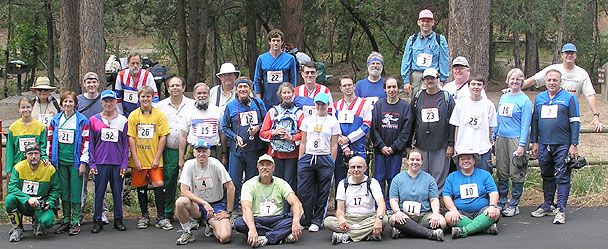

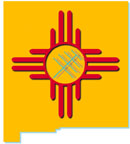
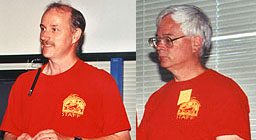 Four years ago, members of the Albuquerque Amateur Radio Club (AARC) made history by putting on USA's first national championships of Amateur Radio Direction Finding. In 2005 they outdid themselves as they staged the fifth annual USA ARDF Championships. This was combined with the Third ARDF Championships of the International Amateur Radio Union (IARU), Region 2. Competitors arrived in Duke City from eleven states and three foreign countries on Monday, heading for the campus of the University of New Mexico (UNM). There they were housed in the school's dormitories and family living quarters, ate in the excellent food-service facility, and exercised their legs on the lawns and pathways.
Four years ago, members of the Albuquerque Amateur Radio Club (AARC) made history by putting on USA's first national championships of Amateur Radio Direction Finding. In 2005 they outdid themselves as they staged the fifth annual USA ARDF Championships. This was combined with the Third ARDF Championships of the International Amateur Radio Union (IARU), Region 2. Competitors arrived in Duke City from eleven states and three foreign countries on Monday, heading for the campus of the University of New Mexico (UNM). There they were housed in the school's dormitories and family living quarters, ate in the excellent food-service facility, and exercised their legs on the lawns and pathways.
At the opening meeting on Tuesday morning, all were welcomed by event co-chairs Jerry Boyd WB8WFK and Mike Pendley K5ATM (above right). WB8WFK was a member of ARDF Team USA 2004 at the World Championships in the Czech Republic (see related story below). Other core members of the organizing committee were Scott Stevenson KC5VVB, Mike Eaton K5MJE and Jack Stump KD5OEO.
The would-be medal-winners got a thorough review of international ARDF rules and the electronic scoring system (e-punch) that would be used, courtesy of Los Angeles Orienteering Club. Participants weren't told where the competition sites would be, but they were reminded of the hazards of dehydration and sunburn at high altitudes. They were advised to be mindful of the possibility of bears and mountain lions in the forest. Actually, these critters were more likely to be encountered by the volunteers placing the transmitters in the early morning hours than by radio-orienteers later in the day.
Although most ARDF participants are licensed hams, the championship courses were open to anyone of any age, with or without an Amateur Radio license. They were separated into five age categories for males and four for females in accordance with IARU rules. All would have to hunt independently on the courses -- no teaming is allowed.
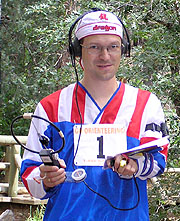
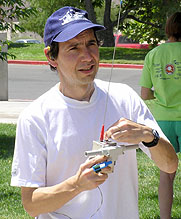 After lunchtime, the two-meter FM and eighty-meter CW practice transmitters were on the air. Everyone had a chance to make sure his or her direction finding equipment, whether owned or borrowed, was in tip-top shape.
After lunchtime, the two-meter FM and eighty-meter CW practice transmitters were on the air. Everyone had a chance to make sure his or her direction finding equipment, whether owned or borrowed, was in tip-top shape.
About 8:30 AM Wednesday, competitors boarded buses at UNM for the ride to Oak Flats in the Cibola National Forest, southeast of the city at over 7000' elevation. Before long, the first groups of radio-orienteers were on the course, keeping track of their positions on the excellent orienteering map that had been prepared and field-checked by AARC members. The two-meter course was six kilometers point-to-point from the start to each of the five transmitters and then the finish. The total distance traveled by competitors was greater of course, especially for those who stayed mainly on the trails or had problems with direction-finding. The typical summer monsoon pattern of strong afternoon mountain thunderstorms had not begun -- there was only an occasional rumble of thunder.
The best performance on two meters was by Vadim Afonkin of Boston, Massachusetts in the M21 category (above left). He found all five transmitters in 1:04:37, ahead of Matthew Robbins AA9YH of Indiana and Scot Barth KA6UDZ of California, who were second and third in that category respectively. A slightly better time (1:02:24) was posted by Bryan Ackerly VK3YNG of Australia (above right), but for only four required transmitters in the M40 category. Bryan bested Jiri Suchy OK1WAY of the Czech Republic and Charles Scharlau NZØI of North Carolina, who took second and third respectively in M40.
In the hotly contested M50 category, Alexandr Kochergin UN7JR of Kazakhstan found the four required 2m foxes in 1:24:18 to beat Bob Frey WA6EZV of Ohio and Larry Benko WØQE of Colorado, who took silver and bronze in that order. In M60 category, long-time orienteer Bob Cooley KF6VSE of California had the excellent time of 1:06:12 for the three required foxes, ahead of second-place Harley Leach KI7XF of Montana and third-place Marvin Johnston KE6HTS of California. In other contested categories, gold went to Karolina Sucha of Czech Republic in D19 and to Karla Leach KC7BLA in D50.
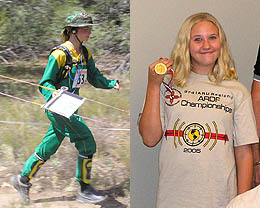
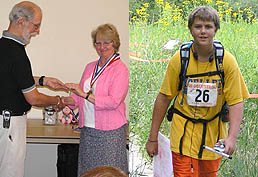 Thursday was devoted to R&R. Since many attendees didn't have their own vehicles, AARC arranged for two free shuttle buses from UNM to Old Town and other areas for the shopping, museums, the zoo, aquarium and botanical gardens.
Thursday was devoted to R&R. Since many attendees didn't have their own vehicles, AARC arranged for two free shuttle buses from UNM to Old Town and other areas for the shopping, museums, the zoo, aquarium and botanical gardens.
Rested and refreshed, the radio-orienteers boarded buses on Friday morning to another unexpected destination for the 80m contest. This time, the trip ended at Doc Long Picnic Area in Sandia Park, northeast of town on the road to the Sandia Peak ski area. There's no skiing in August, of course, but there were cool forests and beautiful fields of flowers on this mostly cloudy day.
Friday's 80m course had approximately the same point-to-point length as Wednesday's two-meter course, but trails and terrain made for greater travel and longer times. Once again, Bryan Ackerly VK3YNG had the best time of the day (1:13:27) in finding his required four foxes. Medal placings in that category (M40) were the same as they were on two meters. In M21, the prime age division for men, Vadim Afonkin again had the best time (1:42:57) for five foxes. Second place in M21 was taken by Jay Thompson W6JAY and third place by Matthew Robbins AA9YH.
In M50, the winner again was Alexandr Kochergin UN7JR with a time of 1:27:33. Silver in M50 was taken by Jay Hennigan WB6RDV of California and bronze by Dick Arnett WB4SUV of Kentucky. The 80m results for M60, D19 and D50 categories were the same as on two meters. Also winning gold on both two meters and 80 meters were Jennifer Harker W5JEN of Texas in D21 and Nadia Scharlau of North Carolina in D35.
The 80m hunt progressed smoothly and the bus got back to UNM in plenty of time for everyone to freshen up before the awards ceremony, featuring a Mexican buffet dinner. In addition to the usual gold/silver/bronze awards for top three places in each of the nine age/gender categories for Overall and IARU Region 2 only divisions, everyone who completed the course within the time limit and found at least one fox transmitter received a participant medal. Awards were presented by Bill Weatherford KM5FT, ARRL's Section Manager for New Mexico.

As in 2001 and 2002, there was a friendly rivalry between the nine competitors from California (Team CA pictured at left above) versus the five who trained together in southern Ohio, southeast Indiana and northern Kentucky (Team OH-KY-IN pictured at right above). In 2005, Team OH-KY-IN garnered three gold, eight silver and five bronze medals. The Californians went home with five gold, five silver and eight bronze.
Hats off to all the AARC officers and members, whose months of work yielded a highly successful championships. You can see dozens more photos here, along with links to other participants' pictures. Complete results, including the competitors' splits (elapsed times for each transmitter found) can be viewed at AARC's official Web site for the 2005 USA and IARU R2 championships.
Joe Moell KØOV
USA ARDF Coordinator
Report and photos copyright © 2005 Joseph D. Moell. All rights reserved.
 Go to Championships Foxhunting News -- Recent and upcoming ARDF championships events
Go to Championships Foxhunting News -- Recent and upcoming ARDF championships events
Go to International-Style Foxhunting Comes To The Americas -- How we're getting the ball rolling
Go to Equipment Ideas for Radio-Orienteering -- Simple and inexpensive receiving and transmitting solutions
Go to Radio-Orienteering News for Southern California -- Results and stories of recent radio-orienteering events in southern California, plus announcements of upcoming ones.
Go to Foxhunting for Scouts -- Let's get the kids involved
 Back to the Homing In home page
Back to the Homing In home page
This page updated 4 April 2006